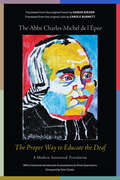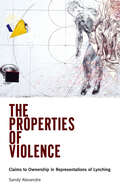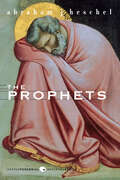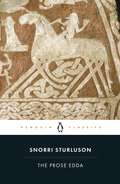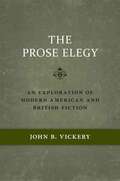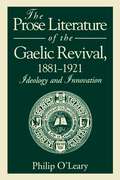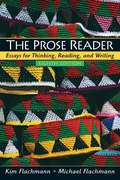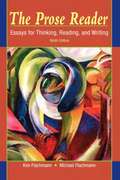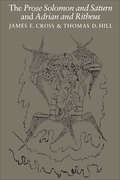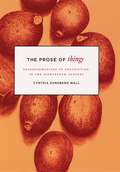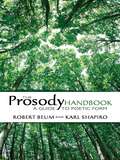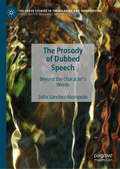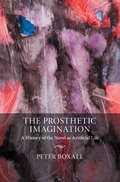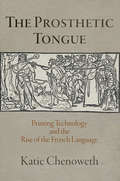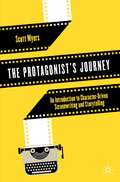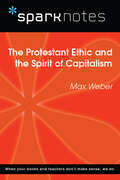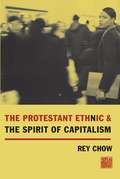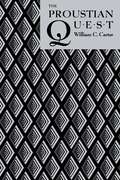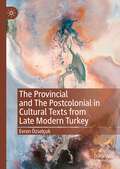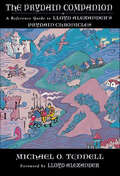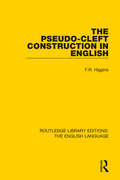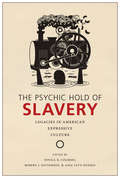- Table View
- List View
The Proper Way to Educate the Deaf: A Modern Annotated Translation
by The Abbé de l’EpéeThis volume presents the first complete English translation of the Abbé de l’Épée’s seminal work describing his methodology for educating deaf children. Originally published in French in 1798, this modern annotated edition offers readers a translation that is documentary in scope and that reflects historic attitudes toward deaf people and deaf education while maintaining the conventions of contemporary English. De l’Épée provides an anecdotal account of his methods and philosophy for educating deaf children using a sign system based on the French Sign Language of the era but adapted to visually represent the linguistic features of spoken and written French. His work laid the foundation for the use of the “manual method,” or sign language, in deaf education. One section of the text, originally published in Latin, outlines the intellectual clash between de l’Épée and Samuel Heinicke, an early proponent of oral education who contested the use of sign language. De l’Épée’s text holds significant cultural and historical value for the fields of deaf studies and deaf education. This English language translation reveals de l’Épée’s own story of how he came to be known as the “father of the deaf” and is enriched by scholarly contributions that provide essential historical context and a framework for modern understanding.
The Properties of Violence: Claims to Ownership in Representations of Lynching
by Sandy AlexandreThe Properties of Violence focuses on two connected issues: representations of lynching in late-nineteenth and twentieth-century American photographs, poetry, and fiction; and the effects of those representations. Alexandre compellingly shows how putting representations of lynching in dialogue with the history of lynching uncovers the profound investment of African American literature—as an enterprise that continually seeks to create conceptual spaces for the disenfranchised culture it represents—in matters of property and territory. Through studies ranging from lynching photographs to Toni Morrison's Pulitzer Prize-winning novel, Beloved, the book demonstrates how representations of lynching demand that we engage and discuss various forms of possession and dispossession. The multiple meanings of the word “representation” are familiar to literary critics, but Alexandre's book insists that its other key term, “effects,” also needs to be understood in both of its primary senses. On the one hand, it indicates the social and cultural repercussions of how lynching was portrayed, namely, what effects its representations had. On the other hand, the word signals, too, the possessions or what we might call the personal effects conjured up by these representations. These possessions were not only material—as for example property in land or the things one owned. The effects of representation also included diverse, less tangible but no less real possessions shared by individuals and groups: the aura of a lynching site, the ideological construction of white womanhood, or the seemingly default capacity of lynching iconography to encapsulate the history of ostensibly all forms of violence against black people.
The Prophets (Perennial Classics Ser.)
by Abraham J. HeschelThe enduring masterpiece on the Old Testament prophets from the legendary twentieth-century Jewish theologian and author of the classics works Man Is Not Alone and God in Search of Man.“A brilliant study of the Hebrew prophets, one of the most penetrating works . . . [of] our time.”— Will HerbergWhen it was first published in 1962, The Prophets was hailed as a masterpiece. Since then, Heschel's classic work has stood the test of time. The Prophets provides a unique opportunity for readers of all faiths to gain a fresh perspective and deep knowledge of the Old Testament and Israel’s ancient prophetic movement. Heschel’s profound understanding of the prophets and detailed examinations of them, including Amos, Hosea, Isahiah, Micah, and Jeremiah, offers crucial insights into the philosophy of religion that continue to hold relevance for modern scholars and laymen alike.
The Prose Edda: Also Called Snorre's Edda Or The Prose Edda
by Jesse ByockThe Prose Edda is the most renowned of all works of Scandinavian literature and our most extensive source for Norse mythology. Written in Iceland a century after the close of the Viking Age, it tells ancient stories of the Norse creation epic and recounts the battles that follow as gods, giants, dwarves and elves struggle for survival. It also preserves the oral memory of heroes, warrior kings and queens. In clear prose interspersed with powerful verse, the Edda provides unparalleled insight into the gods' tragic realization that the future holds one final cataclysmic battle, Ragnarok, when the world will be destroyed. These tales from the pagan era have proved to be among the most influential of all myths and legends, inspiring modern works as diverse as Wagner's Ring Cycle and Tolkien's The Lord of the Rings.
The Prose Elegy: An Exploration of Modern American and British Fiction
by John B. VickeryTraditional English poetic elegists offer both writers and readers hope. After lamenting an individual's death and confronting the mortality of all living things, these poets seek consolation from religion, philosophy, or culture for the inevitability of death. The modern prose elegy, however, follows a different path -- one that determinedly questions all possible resolutions. In The Prose Elegy, John B. Vickery continues the work he began in The Modern Elegiac Temper, which examined the form in British and American poetry. He now considers the works of American and British fiction writers from Henry James to Joan Didion and reveals how the elegy expanded into prose and why it evolved so as to deal not only with death but also with other forms of loss.Focusing on individual works, Vickery explores both the forms the elegy takes throughout the twentieth century and the skeptical and uncertain attitudes of writers struggling to confront the trauma of loss. He offers detailed interpretations of the elegiac components in the works of novelists James Joyce, William Faulkner, Virginia Woolf, and Ernest Hemingway, each of whom forged a distinctive style, as well as chroniclers of a pervasive stoicism, such as Malcolm Lowry and Joan Didion, and writers as nuanced as Sherwood Anderson, F. Scott Fitzgerald, James Agee, and Ford Madox Ford.For these writers, Vickery shows, sorrow intrudes upon the personal, intellectual, and cultural aspects of daily living. By exploring how loss touches each of these areas, their books probe intellectual boundaries and discover new elegiac themes. Truman Capote and John Updike, for example, view memory -- which can disappear quickly -- as inherently sad. They therefore elegize memory. What consoles writers of the modern elegy changes too. In place of Milton's religion or Shelley's philosophy, twentieth-century writers also seek comfort from what also saddens them: family, marriage, and ideas of the self. In The Prose Elegy, Vickery convincingly demonstrates that the elegy remains a dominant mode throughout British and American literature -- with perhaps greater pertinence to our lives than ever before.
The Prose Literature of the Gaelic Revival, 1881–1921: Ideology and Innovation
by Philip O'LearyThe Gaelic Revival has long fascinated scholars of political history, nationalism, literature, and theater history, yet studies of the period have neglected a significant dimension of Ireland's evolution into nationhood: the cultural crusades mounted by those who believed in the centrality of the Irish language to the emergent Irish state.This book attempts to remedy that deficiency and to present the lively debates within the language movement in their full complexity, citing documents such as editorials, columns, speeches, letters, and literary works that were influential at the time but all too often were published only in Irish or were difficult to access. Cautiously employing the terms "nativist" and "progressive" for the turnings inward and toward the European continent manifested in different authors, this study examines the strengths and weaknesses of contrasting positions on the major issues confronting the language movement. Moving from the early collecting or retelling of folklore through the search for heroes in early Irish history to the reworking of ancient Irish literary materials by retelling it in modern vernacular Irish, O'Leary addresses the many debates and questions concerning Irish writing of the period. His study is a model for inquiries into the kind of linguistic-literary movement that arises during intense nationalism.
The Prose Reader: Essays for Thinking, Reading, and Writing (Eighth Edition)
by Kim Flachmann Michael FlachmannThe Prose Reader contains twenty new essays, including an interesting and provocative photo essay. The eighth edition has updated some of the essays, added new authors, and introduced many new topics, such as committing to a place, language acquisition, learning to read, the theory of evolution, girl-fighting, bingeing on college campuses, violence in the United States, gay marriage, graffiti, DNA testing, the Patriot Act, insomnia, and the American Civil War.
The Prose Reader: Essays for Thinking, Reading, and Writing (Ninth Edition)
by Kim Flachmann Michael FlachmannEffective writing through critical thinking. Above all others, this rhetorical patterns reader provides a comprehensive grounding in critical thinking as the foundation for close reading and effective writing. Just as important, by exposing the reader to interesting and insightful prose by a diversity of top writers, the reader is motivated to respond in writing and discussions. By thinking, reading, and writing on three increasingly difficult levels - literally, interpretively, and critically - readers can better learn the processes and skills necessary to be successful in all their writing experiences.
The Prose Solomon and Saturn and Adrian and Ritheus
by Thomas Hill James CrossThere are two prose dialogues in Old English, consisting together of some 109 questions and answers. These questions are related to the medieval Latin Joca Monachorum and Adrian and Epictus dialogues and deal with various and quite diverse topics. Some questions concern scripture and Christian tradition – 'How tall was Adam,' 'where did he get his name,' and 'what are the eight parts of which he was made.' Some questions are scientific or quasi-scientific – 'Where does the sun go at night,' 'what is the number of birds.' Others concern riddles or proverbial lore. Together they are the early medieval equivalent of the Guinness Book of Records, a gathering of odd facts and curious information designed to amuse and entertain. This edition from the British Library manuscripts provides translations of these dialogues, and, more important, traces the sources of these sometimes rather curious ideas. The book will be useful to specialists and students concerned with Old English and medieval literature in general. The texts themselves are of some importance and the illustrative material gathered here is relevant to a wide range of problems. Yet the book is also intended, as were the originals, to amuse and instruct a wider audience, a new age of curious readers.
The Prose of Things: Transformations of Description in the Eighteenth Century
by Cynthia Sundberg WallVirginia Woolf once commented that the central image in Robinson Crusoe is an object—a large earthenware pot. Woolf and other critics pointed out that early modern prose is full of things but bare of setting and description. Explaining how the empty, unvisualized spaces of such writings were transformed into the elaborate landscapes and richly upholstered interiors of the Victorian novel, Cynthia Sundberg Wall argues that the shift involved not just literary representation but an evolution in cultural perception. In The Prose of Things, Wall analyzes literary works in the contexts of natural science, consumer culture, and philosophical change to show how and why the perception and representation of space in the eighteenth-century novel and other prose narratives became so textually visible. Wall examines maps, scientific publications, country house guides, and auction catalogs to highlight the thickening descriptions of domestic interiors. Considering the prose works of John Bunyan, Samuel Pepys, Aphra Behn, Daniel Defoe, Samuel Richardson, David Hume, Ann Radcliffe, and Sir Walter Scott, The Prose of Things is the first full account of the historic shift in the art of describing.
The Prosody Handbook: A Guide to Poetic Form
by Robert Beum Karl ShapiroWritten by two major American poets, this guide to versification is immensely useful for anyone interested in poetry or in general poetic structure. Its systematic study of meter, tempo, rhyme, and other components of verse incorporates countless vivid illustrative examples.Concise and informal, The Prosody Handbook progresses from the smaller elements to the larger: from syllables to feet to lines to stanzas, and from smaller stanzas to larger ones. Its modified notation for marking times and stresses is easily understandable. The extensive and expanded material in the chapter titled "Scansions and Comments" introduces the manifold problems of scansion, confronting readers with the necessity of considering a poem's prosody simultaneously with all its other elements and aspects.A glossary provides ready definitions and illustrations of the most common prosodic terms. A brief chapter covers classical prosody, and the text concludes with an updated bibliography. Both readers and writers of poetry will find this comprehensive volume an essential companion.
The Prosody of Dubbed Speech: Beyond the Character's Words (Palgrave Studies in Translating and Interpreting)
by Sofía Sánchez-MompeánThis book offers a descriptive and practical analysis of prosody in dubbed speech, examining the most distinctive traits that typify dubbed dialogue at the prosodic level. The author's unique perspective - as both a translation studies researcher and a voice-over professional - helps to bring these two aspects of the dubbing process together into a coherent study for the first time. Supported by corpus analysis of English and Spanish episodes of US TV show How I Met Your Mother, she examines aspects of prosody in source and target languages, including features such as intonation, loudness, tempo, rhythm and tension. This book will be of interest to students and scholars of translation and interpreting, media studies, television and film production, as well as dubbing professionals.
The Prosthetic Imagination: A History of the Novel as Artificial Life
by Peter BoxallIn The Prosthetic Imagination, leading critic Peter Boxall argues that we are now entering an artificial age, in which our given bodies enter into new conjunctions with our prosthetic extensions. This new age requires us to reimagine our relation to our bodies, and to our environments, and Boxall suggests that the novel as a form can guide us in this imaginative task. Across a dazzling range of prose fictions, from Thomas More's Utopia to Margaret Atwood's Oryx and Crake, Boxall shows how the novel has played a central role in forging the bodies in which we extend ourselves into the world. But if the novel has helped to give our world a human shape, it also contains forms of life that elude our existing human architectures: new amalgams of the living and the non-living that are the hidden province of the novel imagination. These latent conjunctions, Boxall argues, are preserved in the novel form, and offer us images of embodied being that can help us orient ourselves to our new prosthetic condition.
The Prosthetic Tongue: Printing Technology and the Rise of the French Language (Material Texts)
by Katie ChenowethOf all the cultural "revolutions" brought about by the development of printing technology during the sixteenth century, perhaps the most remarkable but least understood is the purported rise of European vernacular languages. It is generally accepted that the invention of printing constitutes an event in the history of language that has profoundly shaped modernity, and yet the exact nature of this transformation—the mechanics of the event—has remained curiously unexamined.In The Prosthetic Tongue, Katie Chenoweth explores the relationship between printing and the vernacular as it took shape in sixteenth-century France and charts the technological reinvention of French across a range of domains, from typography, orthography, and grammar to politics, pedagogy, and poetics. Under François I, the king known in his own time as the "Father of Letters," both printing and vernacular language emerged as major cultural and political forces. Beginning in 1529, French underwent a remarkable transformation, as printers and writers began to reimagine their mother tongue as mechanically reproducible. The first accent marks appeared in French texts, the first French grammar books and dictionaries were published, phonetic spelling reforms were debated, modern Roman typefaces replaced gothic scripts, and French was codified as a legal idiom.This was, Chenoweth argues, a veritable "new media" moment, in which the print medium served as the underlying material apparatus and conceptual framework for a revolutionary reinvention of the vernacular. Rather than tell the story of the origin of the modern French language, however, she seeks to destabilize this very notion of "origin" by situating the cultural formation of French in a scene of media technology and reproducibility. No less than the paper book issuing from sixteenth-century printing presses, the modern French language is a product of the age of mechanical reproduction.
The Protagonist's Journey: An Introduction to Character-Driven Screenwriting and Storytelling
by Scott MyersCharacter drives plot. Based on this principle, this book walks aspiring writers through the fascinating world of character-driven screenwriting. When a writer engages their characters, they start a process which naturally leads to the story’s structure and everything else that makes for a well-written narrative. Exploring the protagonist’s journey and their “unity arc,” Myers explains how a family of characters surrounds the protagonist and influences their transformation process. This easy-to-follow guide features activities that will help writers of any level develop their stories from concept to scene-by-scene outline. Based upon a popular workshop Myers has led with over a thousand writers at all levels of experience, this book is a must-have for screenwriting students, both undergraduate and graduate, and those looking at advanced story development.
The Protean Text: A Study of Versions of the Medieval French Legend of "Doon and Olive" (Routledge Library Editions: The Medieval World #9)
by Kimberlee Anne CampbellOriginally published in 1988, The Protean Text looks at the shifting evolution of medieval texts and how changing social and aesthetic values were depicted in the literature of the period. The book examines how this was reflected in the reworking and rewriting of texts - a common practice in medieval literature - as various groups adapted existing legends to their own socio-aesthetic needs. Such textual fluidity often resulted in a proliferation of versions. This tendency to experience the text in protean terms is intrinsic to medieval literary expression. This book uses the legend of "Doon and Olive", to discuss the protean text, and uses the diverse series of extant versions available, to enhance our understanding of the possibilities of literary shift and modulation through this period.
The Protestant Ethic and the Spirit of Capitalism (SparkNotes Philosophy Guide)
by SparkNotesThe Protestant Ethic and the Spirit of Capitalism (SparkNotes Philosophy Guide) Making the reading experience fun! SparkNotes Philosophy Guides are one-stop guides to the great works of philosophy–masterpieces that stand at the foundations of Western thought. Inside each Philosophy Guide you&’ll find insightful overviews of great philosophical works of the Western world.
The Protestant Ethnic and the Spirit of Capitalism
by Rey ChowIn late-capitalist Western society, cross-ethnic cultural transactions are an inevitable daily routine. Yet, according to acclaimed cultural critic Rey Chow, the notion of ethnicity as it is currently used is theoretically ambivalent, confusing, indeed self-contradictory, straddling as it does an uneasy boundary between a universalist rhetoric of inclusion on the one hand, and actual, lived experiences of violence and intolerance on the other. To drastically reconceptualize ethnicity in the contemporary world, Chow proposes that it be examined in conjunction with Max Weber's famous theory about the Protestant work ethic and capitalism, which holds that secular belief in salvation often collaborates effectively with the interpellation, disciplining, and rewarding of subjects constituted by specific forms of labor. The charged figure that results from such a collaboration, resonant with the economic, psychological, and spiritual implications of the word "protest, " is what she refers to as the protestant ethnic.Chow explores the vicissitudes of cross-ethnic representational politics in a diverse range of texts across multiple genres, including the writings of Georg Lukacs, Michel Foucault, Max Weber, Jacques Derrida, Fredric Jameson, Etienne Balibar, Charlotte Brontë, Garrett Hongo, John Yau, and Frantz Fanon; the films of Alfred Hitchcock, Marguerite Duras, and Alain Resnais; and the cartoon drawings of Larry Feign. Tracing out hauntingly familiar scenarios from stereotyping and coercive mimeticism to collective narcissistic abjection, the rise of white feminist racial power, and intraethnic ressentiment, Chow articulates a series of interlocking critical dialogues that challenge readers into hitherto unimagined ways of thinking about an urgent topic.
The Protestant Whore
by Alison ConwayAfter the restoration of the English monarchy in 1660, Protestants worried that King Charles II might favour religious freedom for Roman Catholics, and many suspected that the king was unduly influenced by his Catholic mistresses. Nell Gwyn, actress and royal mistress, stood apart by virtue of her Protestant loyalty. In 1681, Gwyn, her carriage surrounded by an angry anti-Catholic mob, famously declared 'I am the protestant whore.' Her self-branding invites an investigation into the alignment between sex and politics during this period, and in this study, Alison Conway relates courtesan narrative to cultural and religious anxieties.In new readings of canonical works by Aphra Behn, Daniel Defoe, Henry Fielding, and Samuel Richardson, Conway argues that authors engaged the same questions about identity, nation, authority, literature, and politics as those pursued by Restoration polemicists. Her study reveals the recurring connection between sexual impropriety and religious heterodoxy in Restoration thought, and Nell Gwyn, writ large as the nation's Protestant Whore, is shown to be a significant figure of sexual, political, and religious controversy.
The Proustian Fabric: Associations of Memory
by Christie McDonaldThe association of ideas became the foundation of Freudian psychoanalysis, informed the nascent semiology of Saussure, and characterized the literary works of Sterne, Joyce, Woolf, and especially Marcel Proust. The author of Remembrance of Things Past, acutely aware of how philosophical, historical, and narrative writing intersected, gave years of thinking and planning to his multivolume masterpiece. Its shape was protean. Each successive volume reconfigured the previous ones and in 1987 Proust readers welcomed the publication of several new editions, among them the Bibliothèque de la Pléiade, which presented as many pages of variants as of text. The Proustian Fabric engages the complex layers of association to be found in Proust's work. According to Christie McDonald, "Remembrance of Things Past straddles the dominant thinking patterns of two centuries: the nineteenth, in which the association of fragmentary thought was to be subsumed into the notion of a totality, and the twentieth, in which the notion of associative thinking was to move toward an infinite process of referral and interpretation." Imbued with McDonald's discerning knowledge of Proust's intellectual and historical milieu, his compendious writing and his critics, The Proustian Fabric is one of the first books to take into account the rich variations of the new editions and to reexamine certain suppositions about Proust's methods, as well as his concern with philosophy, literature, art, and politics.
The Proustian Quest
by William C. Carter"An ambitious study, the fruit of sustained work over many years. Professor Carter's book deploys a stunning knowledge of Proust and places Carter among the first line of Proust scholars in the country."-Roger Shattuck,Boston University The Proustian Quest is the first full-length study that explores the influence of social change on Proust's vision. In Remembrance of Things Past, Proust describes how the machines of transportation and communication transformed fashion, social mores, time-space perception, and the understanding of the laws of nature. Concentrating on the motif of speed, Carter establishes the centrality of the modern world to the novel's main themes and produces a far- reaching synthesis that demonstrates the work's profound structural unity.
The Provincial and The Postcolonial in Cultural Texts from Late Modern Turkey
by Evren ÖzselçukThis book explores Turkey’s complicated relationship to modernity and its status within the new global order by tracing the ambivalent ways in which taşra (the provinces) is constituted in contemporary Turkish cinema and literature. Connoting much more than its immediate spatial meaning as those places outside of the center(s), taşra is a way of naming what modernity decries as spatial peripherality, temporal belatedness, and cultural backwardness. It has functioned historically as a psychosocial repository for what Turkish modernity degrades and disavows, enabling a mapping of the predicaments and contradictions of Turkish modernization and national identity-constitution. Organized around taşra as its central analytic and informed by postcolonial, psychoanalytical, and critical theory, the book examines the extent to which dominant codings of taşra are affirmed and/or complicated in cinematic and literary narratives by award-winning filmmakers Nuri Bilge Ceylan and Fatih Akın and Nobel laureate Orhan Pamuk.
The Prydain Companion: A Reference Guide to Lloyd Alexander's Prydain Chronicles
by Michael O. TunnellAn informative resource for formal studies of the Prydain Chronicles, as well as an excellent opportunity to delve into the fantastic workings of Prydain"The Prydain Companion is more than a quick reference or handy glossary, though it is all of that as well. Instructive, certainly. But, like any good companion, a pleasure to be with over a long period of time." —Lloyd Alexander, from the forewordThis intriguing volume is at once a wonderful reference resource and a vehicle for exploration and discovery in itself. Complete with a biographical sketch of Lloyd Alexander, a personal foreword by Mr. Alexander, a "How to Use the Companion" section from the author, pronunciation keys, excerpts throughout, and—most substantially—an alphabetical guide to the peoples, places, and objects of the Prydain Chronicles, The Prydain Companion is a one-stop reference book for a beloved world of fantasy and magic.For those who love the works of Lloyd Alexander—young readers, teachers, researchers, all—and those who are only beginning to know them, here is a worthy and useful travelmate.
The Pseudo-Cleft Construction in English (Routledge Library Editions: The English Language #13)
by F. R. HigginsThis work, first published in 1979, was a doctoral dissertation submitted to the Department of Foreign Literatures and Linguistics of the Massachusetts Institute of Technology on June 22nd 1973. The ostensible central topic of this essay is a construction which is generally known as the "pseudo-cleft" construction. This essay aims to provide an overall picture of the construction, and show why another treatment of it is necessary. This book will be of interest to those pursuing the topic of copular sentences.
The Psychic Hold of Slavery: Legacies in American Expressive Culture
by Robert J. Patterson Margo Natalie Crawford Brandon J. Manning Aida Levy-Hussen Régine Michelle Jean-Charles Calvin Warren Soyica Diggs Colbert Michael Chaney Douglas A. Jones Jr. Gershun AvilezWhat would it mean to "get over slavery"? Is such a thing possible? Is it even desirable? Should we perceive the psychic hold of slavery as a set of mental manacles that hold us back from imagining a postracist America? Or could the psychic hold of slavery be understood as a tool, helping us get a grip on the systemic racial inequalities and restricted liberties that persist in the present day? Featuring original essays from an array of established and emerging scholars in the interdisciplinary field of African American studies, The Psychic Hold of Slavery offers a nuanced dialogue upon these questions. With a painful awareness that our understanding of the past informs our understanding of the present--and vice versa--the contributors place slavery's historical legacies in conversation with twenty-first-century manifestations of antiblack violence, dehumanization, and social death. Through an exploration of film, drama, fiction, performance art, graphic novels, and philosophical discourse, this volume considers how artists grapple with questions of representation, as they ask whether slavery can ever be accurately depicted, trace the scars that slavery has left on a traumatized body politic, or debate how to best convey that black lives matter. The Psychic Hold of Slavery thus raises provocative questions about how we behold the historically distinct event of African diasporic enslavement and how we might hold off the transhistorical force of antiblack domination.
